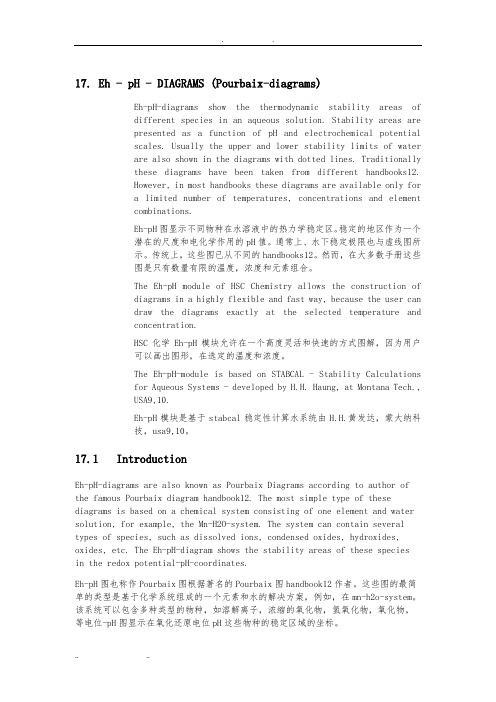HSC-Chemistry使用手册Eh-pH-Diagram模块中文
- 格式:doc
- 大小:166.54 KB
- 文档页数:26

Product descriptionHSC utilises specialist enzymes and a multi surfactant degreasing system to cut through the toughest soils and make floors less slippery.Core benefits• Fast, enzymatic action quickly cuts through the toughest, grease and dirt• Makes floors less slippery and hazardous• Reduced use of hazardous ingredients owing to the inclusion of a VOC free, carbon neutral, plant derived solvent in place of traditional solvents• Concentrated formula, reducing the cost per application.• Advanced detergent/solvent/enzyme combination make an excellent choice for all round maintenance cleaning• pH neutral and safe for all surfaces• Contains a fresh and widely appealing fragrance which revives surfaces and leaves a long lasting pleasant odourHow does it work?A powerful water based enzymatic cleaner that is safer for the user and the environment.It combines with a heavy duty, quick breaking, multi-surfactant system to provide effective wetting, penetrating, soil cutting and anti-redepositing action which allows the quick emulsification and easy lifting of soils, dirt and grease from hard surfaces.The product contains a plant derived, carbon neutral, VOC free eco-solvent which provides the benefit of extra solvency power when cleaning and effectively replaces the need for more conventional and hazardous solvents.The tailored enzyme pack kick starts the breakdown of oily and greasy residues into shorter chain, more soluble molecules, allowing easier, faster removal of greasy deposits.Regular use makes kitchen floors safer for workers, reducing slips.BioHygiene, Beaufort Studio,Atlantic Wharf, Cardiff, CF10 4AHTel************Email:******************.ukDirections for useRinse area to be cleaned with plenty of water to help loosen dirt and grease. Dispense 20-60ml dependent on soiling into a mop bucket and dilute up to 5 litres with clean water.The product may be applied via machine or used for manual cleaning.Product specificationContains: fresh fragrance, water softener, multi-surfactant combination, product specific enzymes.Pack Sizes:1 Litre 5 litresFor further information contact:******************.ukBioHygiene, Beaufort Studio,Atlantic Wharf, Cardiff, CF10 4AHTel************Email:******************.uk。

17. Eh - pH - DIAGRAMS (Pourbaix-diagrams)Eh-pH-diagrams show the thermodynamic stability areas ofdifferent species in an aqueous solution. Stability areas arepresented as a function of pH and electrochemical potentialscales. Usually the upper and lower stability limits of waterare also shown in the diagrams with dotted lines. Traditionallythese diagrams have been taken from different handbooks12.However, in most handbooks these diagrams are available only fora limited number of temperatures, concentrations and elementcombinations.Eh-pH图显示不同物种在水溶液中的热力学稳定区。
稳定的地区作为一个潜在的尺度和电化学作用的pH值。
通常上、水下稳定极限也与虚线图所示。
传统上,这些图已从不同的handbooks12。
然而,在大多数手册这些图是只有数量有限的温度,浓度和元素组合。
The Eh-pH module of HSC Chemistry allows the construction ofdiagrams in a highly flexible and fast way, because the user candraw the diagrams exactly at the selected temperature andconcentration.HSC化学Eh-pH模块允许在一个高度灵活和快速的方式图解,因为用户可以画出图形,在选定的温度和浓度。

outotec hsc chemistry 9模块说明Outotec HSC Chemistry 9模块是一款专业化学分析和过程模拟软件,广泛应用于矿物加工、冶金、环境保护和能源领域。
本文将详细介绍HSC Chemistry 9模块的功能和应用。
HSC Chemistry 9模块拥有强大的化学分析和过程模拟工具,可以帮助工程师和研究人员更好地理解和优化复杂的化学反应过程。
该软件主要具有以下九个模块:1. 平衡:HSC平衡模块可以帮助用户进行化学反应平衡计算,包括气相、溶液相和固体相的平衡。
2. 优化:该模块提供了能够自动寻找最佳条件的工具,通过改变温度、压力、反应物比例等参数,优化反应过程。
3. 热力学:HSC热力学模块可以计算和预测化学反应的热力学性质,如反应熵、焓、平衡常数等。
这对于了解反应的热力学特性非常有帮助。
4. 动力学:该模块能够模拟化学反应速率和动力学行为。
用户可以根据实验数据建立动力学模型,并预测不同条件下的反应速率。
5. 流体力学:HSC流体力学模块提供了用于处理和模拟流体(气体与液体)行为的工具。
用户可以进行流体流动、传热和物质传输等计算。
6. 环境:该模块用于评估化学反应对环境的影响和处理环境相关的问题。
例如,用户可以分析废水处理、大气污染控制等方面的问题。
7. 材料:HSC材料模块提供了对不同材料性质的计算和分析功能。
用户可以预测材料的热力学性质、相图、热膨胀等参数。
8. 分析:该模块用于分析实验数据和生成各种图表和图形。
用户可以根据需要绘制平衡曲线、实验数据对比等。
9. 数据库:HSC化学数据库模块是一个强大的数据库,包含了广泛的化学和物理数据。
用户可以在其中搜索和获取所需数据。
Outotec HSC Chemistry 9模块是一款功能强大的化学分析和过程模拟软件,为工程师和研究人员提供了丰富的工具和资源,帮助他们进行化学反应过程的分析、优化和预测。
无论在矿物加工、冶金、环境保护还是能源领域,HSC Chemistry 9模块都能为用户提供极大的帮助和价值。


工业PH酸度计使用说明书中美合资苏州华能仪控有限公司一、概述CAN_BUS_PH(以下简称PH模块)是我公司现场总线I/O模块家族中的一员,智能网络化PH模块采用低功耗液晶显示界面、数字化网络CAN总线技术,实现了在线仪表数据的远程传输、远程控制和远程参数设置等功能。
网络通讯采用现场总线模式,直接接入电厂DCS/MIS系统。
PH模块广泛应用于电厂、化工、医药、造纸、电子等领域中溶液PH酸度的连续监测。
PH酸度计测量模块,用于将PH、温度的输入信号转换为CAN总线数字信号并上传至上位机。
具有液晶显示、键盘操作和自动温度补偿功能,并可在线修改电极斜率和温度补偿系数。
此外该模块外配数字温度传感器,使温度误差更小,性能更稳定。
隔离输出的工业标准4-20mA电流信号也大大方便了与远程工控的数据传输。
二、仪器特点显示清晰、操作方便1.人机交互界面2.高亮度液晶显示3.操作简单直观易学4.显示被测溶液的pH值、温度值、模块的通道值等网络化1.仪表通过现场总线与微机通讯,实现远程设置与控制2.现场总线上可挂接110 块CAN_BUS仪表功能众多1.由微控制器实现自动温度补偿2.采用高精度温度传感器,精度高,稳定性好3.采用先进的微机技术,电流校正,软件补偿方法,不需调节任何硬件电路来校准电流输出和温度4.提供电导率的隔离4~20mA电流输出三、性能1、测量范围:pH:0-14温度:0--70℃2、基本示值误差:pH≤±0.05pH温度≤±0.5℃3、稳定性:示值漂移±0.25%FS/24小时4、CAN通讯参数:速率125K方式多主四、仪表工作条件⑴环境温度: (0~45)℃⑵相对湿度: <90%⑶供电电源: DC (9-30V)⑷消耗功率: 3W五、PH仪表外观图如图1.1,包括左、右端子排、显示、键盘和状态指示。
左边部分为供电和通讯端子,右边部分为模拟信号端子。
端子名称对应关系:L1---GND 电源输入负L2---VIN+ 电源输入正L3---CANL CAN通讯低L4---CANH CAN通讯高L5---GND 电源输入负L6---VIN+ 电源输入正L7---CANL CAN通讯低L8---CANH CAN通讯高其中电源输入范围为 9V-24VR1---GND DS18B20供电负R2---DQ DS18B20数据R3---VCC DS18B20供电正(4.5~5.5V)R4---IOUT+ 4~20mA电流环24V输入端R5---IOUT- 4~20mA电流环电流输出端(RL<600欧姆)R6--- INPOLE+ PH电极信号正端R7---GND1 PH电极信号地R8--- INPOLE- PH电极信号负端图1.1 pH模块外观六、pH 模块接线端子操作电源、电极和CAN 部分的接线操作和以前近似,只是电源输入范围更宽达到9~30V 。

化工进展Chemical Industry and Engineering Progress2023 年第 42 卷第 4 期粗钨酸钠溶液亚铁盐沉淀法除铬、钒的热力学分析及实验验证贺山明1,2,潘界昌1,徐国钻2,李文君1,梁勇1(1 江西理工大学材料冶金化学学部,江西 赣州 341000;2 崇义章源钨业股份有限公司,江西 赣州 341300)摘要:废硬质合金再生利用过程中得到的粗钨酸盐溶液Cr 、V 含量容易超标,由于Cr 、V 与W 具有十分相似的水溶液性质,粗钨酸盐溶液除铬、钒一直是个技术难题。
本文针对亚铁盐沉淀法从粗钨酸钠溶液中除铬、钒工艺过程进行热力学分析研究,分别绘制了298K 时Cr-Fe-H 2O 体系和V-Fe-H 2O 体系的Eh-pH 图、Cr 6+-Fe 3+-V 5+-H 2O 体系和Cr 3+-Fe 2+-Fe 3+-V 5+-H 2O 体系的热力学平衡图。
热力学分析结果表明:粗钨酸钠溶液中Cr(Ⅵ)在酸性和碱性体系下均能够被Fe 2+或Fe(OH)2沉淀还原,V(Ⅴ)则会与Fe 2+或Fe(OH)2反应生成Fe(VO 3)2沉淀;在Cr 3+-Fe 2+-Fe 3+-V 5+-H 2O 体系中存在Fe(VO 3)2+Fe(OH)3+Cr(OH)3+Fe(OH)2共沉淀稳定区,为亚铁盐沉淀法同时除铬、钒提供了热力学可行性,并获得了沉淀法最佳条件控制区间。
验证实验结果表明:控制溶液的pH 为9、以n (Fe 2+)∶n (V+Cr)=15∶1加入硫酸亚铁沉淀剂时,粗钨酸钠溶液的除铬率高达99.85%、除钒率为95.05%、钨损失率仅为0.33%,实验效果与热力学分析结论基本相符;滤渣的SEM-EDS 分析结果,进一步证实了Fe-Cr-V 共沉淀的技术可行性。
关键词:亚铁盐沉淀法;热力学分析;钒铬同步脱除;钨酸盐溶液中图分类号:TF 841.1 文献标志码:A 文章编号:1000-6613(2023)04-2171-09Thermodynamic analysis and experimental verification of chromium and vanadium removal by ferrous salt precipitation from crude sodiumtungstate solutionHE Shanming 1,2,PAN Jiechang 1,XU Guozuan 2,LI Wenjun 1,LIANG Yong 1(1 Department of Materials Metallurgy Chemistry, Jiangxi University of Science and Technology, Ganzhou 341000,Jiangxi, China; 2 Chongyi Zhangyuan Tungsten Industry Co., Ltd., Ganzhou 341300, Jiangxi, China)Abstract: The content of Cr and V in the crude tungstate solution obtained in the recycling process of waste cemented carbide is easy to exceed the standard. Because Cr, V and W have very similar properties of aqueous solution, the removal of chromium and vanadium from the crude tungstate solution has always been a technical problem. In this paper, the thermodynamic analysis and research on the process of removing chromium and vanadium from the crude sodium tungstate solution by ferrous salt precipitation method were carried out. The Eh-pH diagrams of Cr-Fe-H 2O System and V-Fe-H 2O system at 298K and the thermodynamic equilibrium diagrams of Cr 6+-Fe 3+-V 5+-H 2O system and Cr 3+-Fe 2+-Fe 3+-V 5+-H 2O system at 298K were drawn, respectively. Thermodynamic analysis results showed that Cr(Ⅵ) in crude sodium tungstate solution could be reduced by Fe 2+or Fe(OH)2 precipitation in both acidic and alkaline systems, and V(Ⅴ) would react with Fe 2+ or Fe(OH)2 to form Fe(VO 3)2 precipitation. In Cr 3+-Fe 2+-Fe 3+-V 5+-研究开发DOI :10.16085/j.issn.1000-6613.2022-1170收稿日期:2022-06-22;修改稿日期:2022-08-09。
17. Eh - pH - DIAGRAMS (Pourbaix-diagrams)Eh-pH-diagrams show the thermodynamic stability areas of different speciesin an aqueous solution. Stability areas are presented as a function of pH andelectrochemical potential scales. Usually the upper and lower stability limitsof water are also shown in the diagrams with dotted lines. Traditionally thesediagrams have been taken from different handbooks12. However, in mosthandbooks these diagrams are available only for a limited number oftemperatures, concentrations and element combinations.Eh-pH图显示不同物种在水溶液中的热力学稳定区。
稳定的地区作为一个潜在的尺度和电化学作用的pH值。
通常上、水下稳定极限也与虚线图所示。
传统上,这些图已从不同的handbooks12。
然而,在大多数手册这些图是只有数量有限的温度,浓度和元素组合。
The Eh-pH module of HSC Chemistry allows the construction of diagrams ina highly flexible and fast way, because the user can draw the diagramsexactly at the selected temperature and concentration.HSC化学Eh-pH模块允许在一个高度灵活和快速的方式图解,因为用户可以画出图形,在选定的温度和浓度。
HSC Chemistry is designed for various kinds of chemical reactions and equilibria calculations. The current version contains fourteen calculation modules displayed as fourteen options in the HSC main menu:HSC化学是专为各种化学反应及平衡计算。
当前版本包含十四个计算模块显示在主菜单中选择HSC十四:1. Reaction Equations 8. H, S, C and G Diagrams1。
反应方程式8。
H,S,C和G图2. Heat and Material Balances 9. Phase Stability Diagrams2。
热量和物质平衡相图的9。
3. Heat Loss Calculations 10. Mineralogy Iterations3。
热损失计算10矿物学迭代。
4. Equilibrium Compositions 11. Composition Conversions4。
平衡组成成分转换11。
5. Electrochemical Equilibria 12. Elements5。
电化学平衡12要素。
6. Formula Weights 13. Water (Steam Tables)6。
配方重量的13,水(蒸汽表)。
7. Eh - pH – Diagrams 14. Units7。
嗯,pH–图14单位。
The name of the program is based on the feature that all fourteen calculation options automatically utilize the same extensive thermochemical database which contains enthalpy (H), entropy (S) and heat capacity (C) data for more than 17000 chemical compounds. This database is equivalent to more than seventeen thick data books.该程序的名称是基于所有的十四计算选项自动使用同样广泛的热化学数据库包含焓特征(H),熵(S)和热容量(C)超过17000的化合物的数据。
e+h余氯英文说明书以下是E+H(Endress+Hauser)余氯传感器的英文说明书的全面解释:The E+H residual chlorine sensor is an advanced device designed for accurate and reliable measurement of residual chlorine levels in various applications. It is commonly used in water treatment plants, swimming pools, and industrial processes where the monitoring of chlorine concentration is crucial.The sensor utilizes a unique amperometric measurement principle to detect residual chlorine. It consists of a working electrode, a reference electrode, and anelectrolyte solution. When the sensor comes into contact with water containing chlorine, a redox reaction occurs at the working electrode, generating a current proportional to the chlorine concentration.The E+H residual chlorine sensor offers several keyfeatures and benefits. Firstly, it provides real-time and continuous measurement, allowing operators to monitor chlorine levels in real-time and take appropriate actions if necessary. This helps ensure the safety and effectiveness of water treatment processes.Secondly, the sensor is highly accurate and reliable. It is calibrated at the factory and can be easily recalibrated if needed. The use of high-quality materials in its construction ensures long-term stability and durability, even in harsh environments.Furthermore, the sensor is designed for easy installation and maintenance. It can be directly immersed in the water or installed in a flow cell, depending on the application requirements. The sensor is also equipped with a self-cleaning system to prevent fouling and ensure optimal performance.In terms of compatibility, the E+H residual chlorine sensor is compatible with various E+H transmitters and controllers, allowing seamless integration into existingmonitoring systems. It can also be connected to a computer or SCADA system for remote monitoring and data logging.In conclusion, the E+H residual chlorine sensor is a state-of-the-art device that provides accurate and reliable measurement of residual chlorine levels. Its advanced features, ease of installation, and compatibility make it an ideal choice for a wide range of applications. Whetherin water treatment plants or industrial processes, this sensor ensures the efficient and safe management ofchlorine concentration.。
17. Eh - pH - DIAGRAMS (Pourbaix-diagrams)Eh-pH-diagrams show the thermodynamic stability areas of different speciesin an aqueous solution. Stability areas are presented as a function of pH andelectrochemical potential scales. Usually the upper and lower stability limits ofwater are also shown in the diagrams with dotted lines. Traditionally thesediagrams have been taken from different handbooks12. However, in mosthandbooks these diagrams are available only for a limited number oftemperatures, concentrations and element combinations.Eh-pH图显示不同物种在水溶液中的热力学稳定区。
稳定的地区作为一个潜在的尺度和电化学作用的pH值。
通常上、水下稳定极限也与虚线图所示。
传统上,这些图已从不同的handbooks12。
然而,在大多数手册这些图是只有数量有限的温度,浓度和元素组合。
The Eh-pH module of HSC Chemistry allows the construction of diagrams ina highly flexible and fast way, because the user can draw the diagrams exactlyat the selected temperature and concentration.HSC化学Eh-pH模块允许在一个高度灵活和快速的方式图解,因为用户可以画出图形,在选定的温度和浓度。
The Eh-pH-module is based on STABCAL - Stability Calculations forAqueous Systems - developed by H.H. Haung, at Montana Tech., USA9,10.Eh-pH模块是基于stabcal稳定性计算水系统由H.H.黄发达,蒙大纳科技,usa9,10。
17.1 IntroductionEh-pH-diagrams are also known as Pourbaix Diagrams according to author of the famousPourbaix diagram handbook12. The most simple type of these diagrams is based on achemical system consisting of one element and water solution, for example, the Mn-H2O-system. The system can contain several types of species, such as dissolved ions, condensedoxides, hydroxides, oxides, etc. The Eh-pH-diagram shows the stability areas of these speciesin the redox potential-pH-coordinates.Eh-pH图也称作Pourbaix图根据著名的Pourbaix图handbook12作者。
这些图的最简单的类型是基于化学系统组成的一个元素和水的解决方案,例如,在mn-h2o-system。
该系统可以包含多种类型的物种,如溶解离子,浓缩的氧化物,氢氧化物,氧化物,等电位-pH图显示在氧化还原电位pH这些物种的稳定区域的坐标。
Usually the redox potential axis is based on the Standart Hydrogen Electrode (SHE) scale designated Eh, but other scales can also be used. The redox potential of the system representsits ability to change electrons. The system tends to remove electrons from the species whenthe potential is high (Eh > 0). These conditions may exist near the anode in theelectrochemical cell, but can also be generated with some oxidizing agents (Cu + H2O2 =CuO + H2O). In reducing conditions, when potential is low (Eh < 0), the system is able tosupply electrons to the species, for example, with a cathode electrode or with some reducing agents.通常氧化还原电位轴是基于标准氢电极(她)规模划啊,但也可以使用其他表。
该系统的氧化还原电位代表其改变电子的能力。
系统会删除电子从物种可能是当高(EH >0)。
这些条件可能存在在电化学电池的阳极,但也可以与一些氧化剂(H2O2生成Cu+铜+ H2O =)。
在还原条件下,当为低电位(Eh<0),该系统能够提供电子的物种,例如,与阴极电极或与还原剂。
The pH of the system describes its ability to supply protons (H(+a)) to the species. In acid conditions (pH < 7) the concentration of the protons is high and in caustic conditions (pH > 7)the concentration of protons is low.pH值的系统描述其提供质子的能力(H(+))的种类。
在酸性条件下(pH<7)质子的浓度较高,在碱性条件下(pH>7)的质子浓度低。
Usually a large amount of different species exist simultaneously in the aqueous mixtures infixed Eh-pH-conditions. The Pourbaix diagrams simplify this situation a lot by showing onlythe predominant species which content is highest in each stability areas. The lines in thediagrams represent the Eh-pH-conditions where the content of the adjacent species is thesame in the equilibrium state. However, these species always exist in small amounts on bothsides of these lines and may have an effect on practical applications.通常一个大的不同物种的数量同时存在固定的Eh-pH条件水混合物。
Pourbaix图简化这种情况很多只显示优势种,内容是每个稳定性最高的地区。
图中的线代表Eh-pH条件下相邻物种的内容是在平衡状态下相同。
然而,这些品种都存在少量的这些线的两侧,可能对实际应用的影响。
The lines in the diagrams can also be represented with chemical reaction equations. Thesereactions may be divided into three groups according to reaction types:图中的线也可以用化学反应方程式。
这些反应可分为三组,根据反应类型:1. Horizontal lines. These lines represent reactions that are involved with electrons,but are independent of pH. Neither H(+a)-ions nor OH(-a)-ions participate to these reactions.1水平线。
这些线代表的反应,涉及电子,但独立的博士没有H(+)离子和OH(-)-离子参与反应。
2. Diagonal lines with either positive or negative slope. These lines representreactions that are involved with both electrons and H(+a)-and OH(-a)-ions.2。
对角线或正或负的斜率。
这些线代表的反应,涉及电子和H(+)和(-)-离子哦。
3. Vertical lines. These lines represent reactions that are involved either with H(+a)-or OH(-a)-ions, but are independent of Eh. In other words, electrons do not participate withthese reactions.3垂直线。
这些线代表反应,可能与H(+)或(-)-离子哦,但独立的啊。
换句话说,电子不参与这些反应。
The chemical stability area of the water is shown in the Eh-pH-diagrams with dotted lines.The upper stability limit of water is based on the potential when the oxygen generation startson the anode. It is specified by the reaction:水的化学稳定性区域是在虚线的Eh-pH图所示。